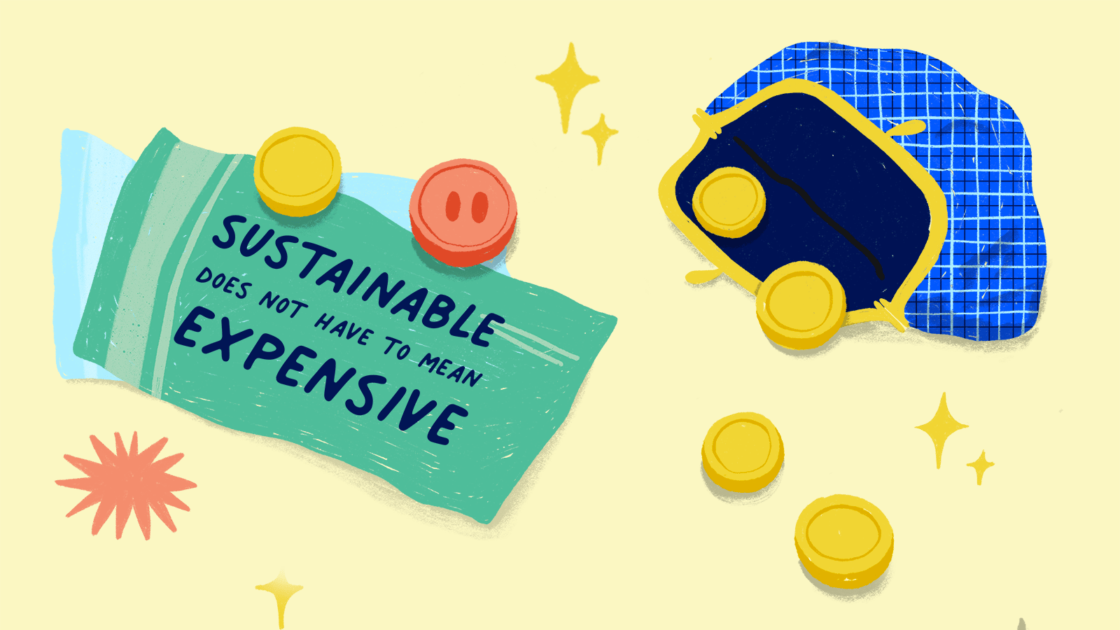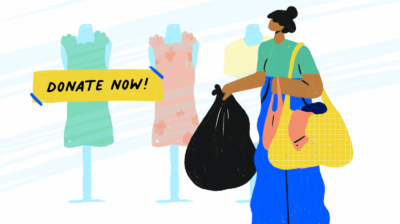Sustainable fashion on a budget
Sustainable fashion does not always mean expensive fashion. Find out how you can shop sustainable styles on a budget.


If you’re interested in sustainable fashion but it feels like sustainable clothing is simply too expensive, there are lots of options available even on a small budget. Buying less is one of the best ways to slow fashion, and shopping sustainably doesn’t always have to mean buying clothes from ethical or sustainable fashion companies with a higher price tag – there are many ways you can be sustainable and it doesn’t have to be perfect. What matters is that you’re making a contribution.
What’s wrong with fast fashion?
The fast fashion industry rapidly produces a large amount of clothing. It is often made of cheap, synthetic materials and of poor quality to keep costs low. It thrives off our ‘take, make waste’ economic model and quickly fading high street trends.
Fast fashion brands generate a lot of waste in production and often dump it straight into local streets and waterways. They treat workers poorly and pay them badly. A lot of clothes end up in landfills due to being poor quality and a culture of waste that is driven by fast fashion marketing and social media influencers. This has a negative effect on our environment and contributes to climate change.
How to be sustainable on a small budget
If you’re looking for ways to make your wardrobe more eco-friendly while reducing your costs, here are some things to try.
Wash your clothes less often and at lower temperatures
Washing clothes at lower temperatures and less often is a great first step to being more sustainable while also helping you to lower your costs.
Washing at 30 degrees or under can save you money on electricity, bring down your use of water and detergents, and make your clothes last longer. Most items can be washed at 30 – just separate these from things like sheets and towels that need to be washed at 60 degrees for hygiene reasons.
It’s also worth asking yourself if something really needs to go into the laundry basket. A lot of the time, items can be worn a few more times before they need to be washed. Here are some things you can do to get more out of your clothes in between washes:
- Air out clothes on a washing line
- Steam them
- Spot clean
Washing less also keeps your clothes in good condition. Environmentally friendly detergents, solutions like eco eggs and soap nuts and washing bags you can buy to catch micro-plastics are other options but can be a bit more pricey.
Choose second hand
Buying second hand clothes is a great way to get cheap, sustainable and good quality clothes. If you look hard you can end up with some really unique items of clothing.
You can find bargains on sites like Depop, Ebay, Thriftify, Instagram, Done Deal or Facebook Marketplace. Charity shops are also a great way to find affordable second hand pieces and support a good cause.
You could also take it one step further and look for sustainable materials when you’re buying second hand. Clothes made of these synthetic materials like polyester and nylon release tiny particles called microfibres when you wash them. Washing synthetic clothes is responsible for 35% of microplastics in our environment, according to statistics from the European Parliament – this is another good reason to wash your synthetic clothes less often if you can.
Arrange a swap shop event
Swap shops, where you exchange items of clothing you no longer want for other peoples clothing, are also a good way to try out some new styles without paying money or creating waste. You could set up one between friends,at your school or college, or local youth club.
How to set up a swap shop:
- Talk to your friends or classmates to gauge interest
- Confirm 5-15 people who are interested in the shop
- Check that each person will be able to swap clothing with at least two others in the same size range
- Consider an entry fee to cover the cost of the location or snacks
- Get a location (like your school, community centre or even a football pitch), with tables or racks for the clothing
- Choose a date
- Create a guide (no money, clean clothes only etc)
- Send out invites
Repair, reuse or recycle your clothes
If you have clothes that are ripped or worn, consider learning simple sewing techniques so you can patch up elbows, darn a hole or reattach straps at home. There are plenty of tutorials online, and if you get really good you can try upcycling old clothes into new styles. Starting your own sewing box, with essentials such as needles and thread can help you with the basics of mending clothes yourself.
You can also explore ways to reuse old clothes. For example, if you have old socks or things that are past the point of being wearable, you can try reusing them as cleaning cloths or cut the fabric into strips and use them to make handmade rugs or plant holders.
Try your best not to throw things away. The amount of clothes we use and throw away is an issue for the environment. Just Ireland sends 63,000 tonnes of textiles to landfills every year and globally less than 1% of clothes are recycled as clothing because of a lack of technology, according to the Ellen MacArthur Foundation.
Be an activist
Educating your friends and family on the topic of clothing waste and the fashion industry’s impact on the environment is a way to be actively sustainable – and it’s totally free. It will help inform the people that have the means to make changes.
You can join online groups and campaigns aiming to change the fast fashion industry. Reading and watching documentaries on this topic can help with your own knowledge too. Find out more about becoming more active in the sustainable fashion community.
It is okay to not be 100% sustainable
You might need a winter coat, but live in rural Ireland where there’s a poor selection of charity shops. Or maybe your size has changed and you really need a lot of new essentials – it’s okay to buy new and cheap clothing.
Try and keep the clothes for a long time, wear them plenty and pass old clothes on to friends and family or donate them. Or if you have time you can have a look at Good On You to see if there are any affordable brands you can order from that have a better than average sustainability rating. Don’t be hard on yourself for doing what you need to do to get by. You can always campaign, educate yourself and start conversations on fast fashion and its impact on the environment.
Cover image by Cathy Hogan






